|
(Part Two: Software now online!)
Unless you're not a gamer (which would be odd since this is
RetroGAMES), you already know about the Gameboy Advance, and it's
stylish
new variant, the GBA SP. However, unless you're a hardcore fan of
portable systems, you
may not have heard much about the GP32. It's a portable system from
the
South Korean company Game Park, and currently is only sold in South
Korea.
Fortunately
it can be imported, and there are English versions which include an
English
language BIOS and manual. Alright, it's "Engrish," but that just adds
to the fun!
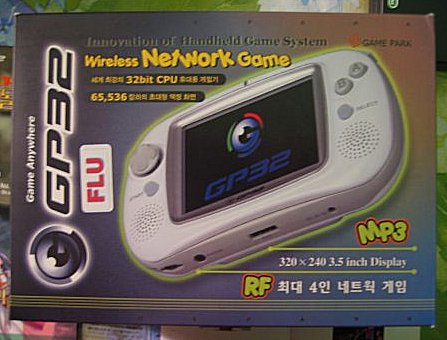
I ordered my GP32 FLU from Play-Asia, using EMS shipping. They
have good prices (GP32 FLU is ~$210), quick service and shipping is
relatively inexpensive
to the USA. Tom
at Play-Asia was also quick to reply to emails, and kindly replaced my
first GP32 FLU when I accidentally scratched the inside of my screen
trying to remove dust particles (more on that later). I didn't expect
them to replace my unit, although admittedly at that point they were
aware of my ties to Retrogames and my upcoming GP32 FLU review. Either
way, they had no obligation to replace the unit after I botched it, so
I'm grateful. If by chance your FLU screen is ever damaged, I did
contact the company that manufactures them for Game Park - HaHotech. They informed me that FLU
kits can be purchased directly from them by existing FLU owners for $30,
or you can send your GP32 FLU to them (all the way in South Korea) and
they'll replace your damaged FLU for $50. Thankfully Play-Asia saved me
from doing either of those, but it's nice to know the options exist if
they're ever needed.
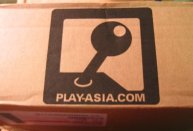
I can't mention GP32 and places to buy them without giving a nod to
Craig and his store, GBAX. He was
momentarily out of stock when I was ready to buy, but he's not only a
reliable and reputable GP32 seller, but an active GP32 developer as
well. I'd like to convey my personal thanks to Craig for his great work
on the GP32 Doom port, it r0x in a major way!
My initial order included the GP32 FLU, an official GP32 carrying
case (which is very nice!) and two commercial GP32 games: Tomak Save
The Earth Again and Her Knights: All For Princess.
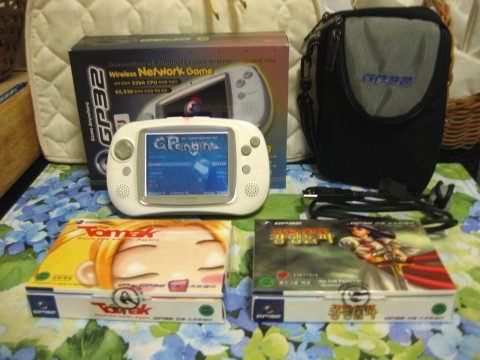 Here's everything I bought.
Here's everything I bought.
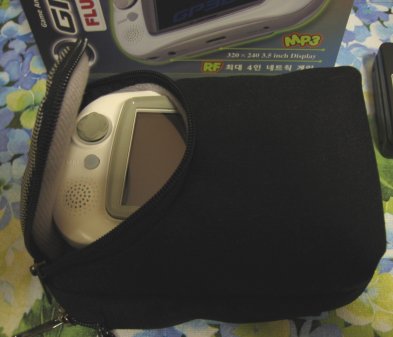 Snug as a bug... The bottom half of the case holds everything else.
Snug as a bug... The bottom half of the case holds everything else.
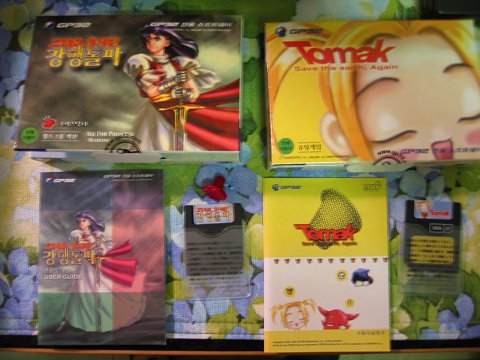 Commercial GP32 games, contained on 16MB SmartMedia cards.
Commercial GP32 games, contained on 16MB SmartMedia cards.
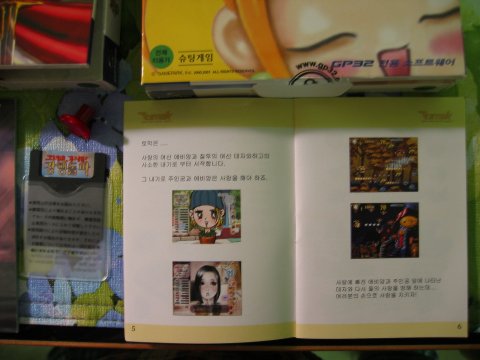 Full color illustrated manuals, albeit in Korean.
Full color illustrated manuals, albeit in Korean.
Normally the GP32 does not include internal lighting, but recently a
new
version
called the "GP32 FLU" was released, which stands for "Front Light Unit."
The
GP32 FLU includes the equivalent of the front light found in Afterburner
GBA's
or the GBA SP. It is exactly the same lighting technology. This review
will be
about this new version of the GP32.
Where to begin... Well, take a look at the unit:
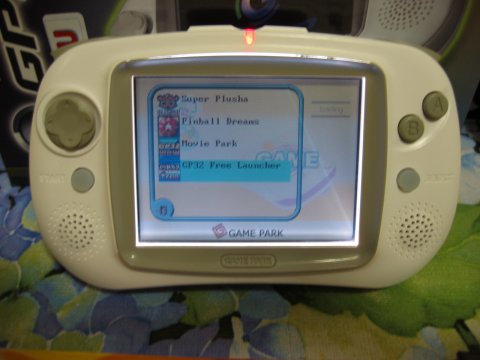
As you can see, the design is very similar to the original GBA, and
situated
next to an Arctic GBA, they could be brothers. Here's a few different
systems to compare (Top to bottom: NGPC, GP32, GBA, and folded GBA SP on
the right):
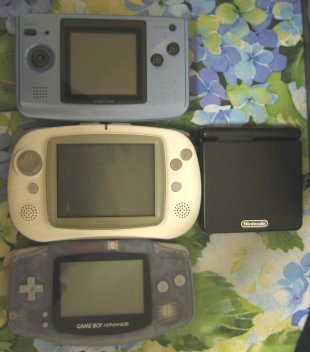
And here they are stacked (Top to bottom: GBA SP, GP32, GBA, NGPC):
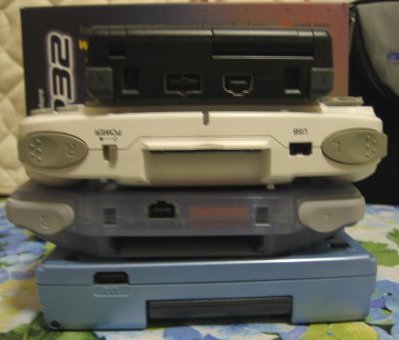
You've probably noticed the display is larger on the GP32 (3.5"
compared to the GBA's 2.9"), there
are two
speakers, and the controls are somewhat different. The LCD on the GP32
is slightly brighter than the GBA's
LCD, which is notoriously dark. With the FLU turned on, via a button on
the back
of the unit, the screen is easily viewed in the dark, just like the GPA
SP or an
Afterburner GBA. However, there's more to see on the GP32, not only
because the
screen is physically larger, but because it's twice the resolution of
the GBA (
320x240 vs. 240x160). This increased resolution means more detailed
graphics,
and the ability to present emulated systems (more on those later) with
pixel
perfect accuracy.
The question on most gamer's minds at this point is: how does the
GP32 FLU display compare with the GBA SP display? Well, here's a few
comparison photos:
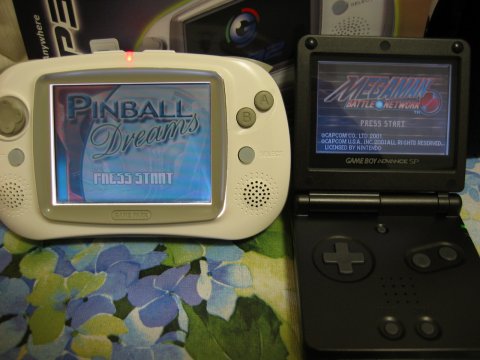
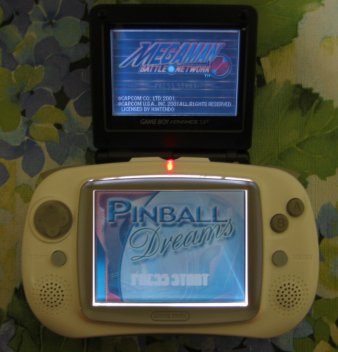
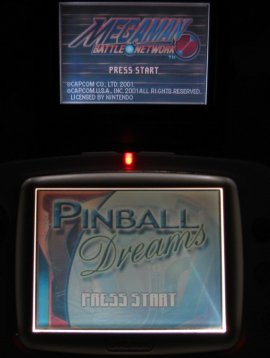
Alright, so we've got a bright, well lit, large, detailed display.
Now
for the
downside - dust and trapezoid effect. Just about every device that uses
frontlighting seems to suffer from dust getting caught betwixt the
plastic outer
lens and the light guide beneath. With the light off, these dust
particles aren'
t really apparent, but with the light on they become illuminated. I've
seen $500
iPaq's with dust, my GBA SP has one or two bits, and sadly my GP32 FLU
has
several, although not as many as my Afterburner GBA. Once you start
playing they disappear from your conciousness, but so
many gamers are perfectionists it's worth noting. Next, we have
trapezoid effect:
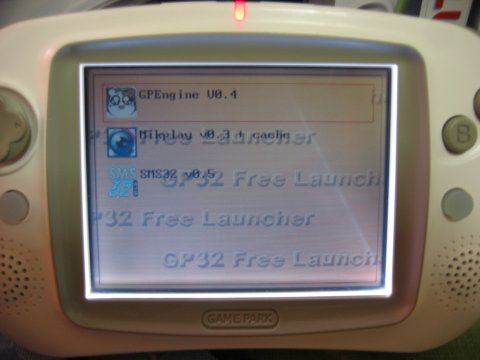
See that bluish/pinkish line extending from the lower right corner
into the
horizon of
the display? That's trapezoid effect. I'm not sure what causes it, but I
believe it's
related to how perfectly aligned the front light is installed. My
Afterburner
GBA has this too, my GBA SP doesn't, unless you turn it to certain
angles. It's
an imperfection, it's only there when the light is on (of course), and
like the
dust, it also disappears once you start using the system. But just be
aware that
if you purchase a GP32 FLU, you might experience similar issues.
If you
purchase
a GP32 without FLU, you won't have either one. But I highly recommend
getting
the FLU simply because it works great, and allows you to easily play the
GP32 in
any lighting condition as already noted. FLU kits should also become
available
soon for do-it-yourselfers, so that's another option.
Please note: Play-Asia kindly replaced my first unit (after I
damaged it trying to remove dust particles) and I have very good news.
The new unit has less trapezoid effect and just one or two
microscopically small particles of dust! That's about the same as my GBA
SP. This may bode well for future GP32 FLU buyers. I'm fairly sure my
first unit was one of the first FLU units made, and I suspect the Game
Park factory has improved their installation methods since that initial
batch. I should also note that ALL PHOTOS in this review are of my OLD GP32 FLU before I damaged it.
Next we have controls. If you've ever had the good fortune to use a
NeoGeo
Pocket or NeoGeo Pocket Color, then you've had a preview of the GP32's
controls.
They are simply perfect, with one caveat. The shoulder buttons are not
as
responsive as they could be, requiring the user to press them all the
way in. It'
s a relatively minor quibble though, because they work fine otherwise,
and the
other controls are sheer perfection. The thumb stick functions as a mini
joystick, and is very responsive, accurate and painless. The GP32
absolutely
destroys the GBA, and especially the GBA SP, when it comes to comfort,
allowing
the player to enjoy longer sessions without cramping. The primary face
buttons,
including A, B, Start and Select, are perfectly sized, comfortably
situated and
very responsive. The GP32 simply has the best controls I've seen on any
portable gaming
device, hands down. Some gamers might've wished for a PSX style 4 button
layout,
but Game Park decided to follow Nintendo's stubborn addiction to having
only 2
main buttons. At least the Select button is a short space away from A
and B,
which comes in handy when you need another button.
As for sound, the GP32 goes the extra mile with stereo speakers. They
work, they're much louder than the GBA, but just don't expect high
fidelity. Not to mention the fact that Game Park mysteriously installs
the speakers in reverse... Or so I'm told. I use headphones 90% of the
time. Plug
some
headphones in the jack on the bottom left of the GP32 and you'll find
the sound
output is unusually loud, which is great since the GP32 also includes a
very
decent MP3 player right in the BIOS. Yep, that's right - you can use it
as a
perfectly functional music player right out of the box, although you'll
need to buy
a Smart Media card to store your files on. I'll discuss using Smart
Media with the
GP32 later in the review.
To power the GP32, you have 3 basic choices. You can use 2 standard
AA
batteries, which are estimated to yield around 10 hours of play time
without FLU lighting, and 5 or 6 hours with FLU lighting. You can also
use rechargeable AA batteries, which I highly recommend, or a 3v AC
adapter if you're playing at home. Using some Radio Shack 1800 mAh
rechargeable AA's, I've been getting superb results, very similar to
using fresh Alkaline AA's. There simply is no reason to buy single use
batteries these days - they're much more expensive in the long run, and
are
wasteful in general. To charge my batteries I purchased a wonderful
little unit from Radio Shack for around $14 pictured below. It's
compact, charges up to 4 batteries at one time, and doubles as a
selectable voltage AC adapter (3v - 9v with 5 settings, GP32 uses 3v)
and a portable AC power pack if you leave charged batteries inside. When
you purchase the unit, you get to choose one free plug - for GP32 choose
type A, which is the white plug you can see draped over the GP32 screen
below.
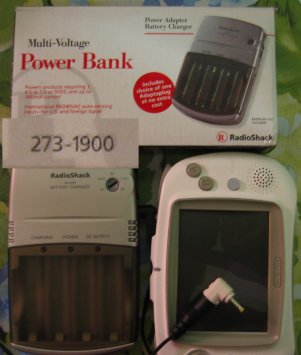
As for the rest of the GP32, you'll find the (tight fitting)
SmartMedia card slot at middle top of the unit, right where the you'd
find the cartridge slot on a typical game system. On the top left is the
USB port, which is used to connect the GP32 to a PC. On the back you've
got
your usual battery cover. And along the bottom, from left to right,
there's the volume control, headphone plug, EXT slot (for the RF
adapter, which I don't own), and the AC adapter input. Included with the
GP32 is a USB cord and instruction booklet, albeit in odd but
comprehensible Korean style "Engrish." You're on your own for batteries
and other items.
Which brings us to SmartMedia cards... Granted, you can use the GP32
as a typical portable game system and just buy commercial games (which
generally come on 16Megabyte SmartMedia cards (AKA SMC's). However, if
that's all you intend to do, then stick to GBA. The GP32 has very few
good commerical games IMO, although there are one or two gems, and you
need SMC's to use the MP3 player in the BIOS. Plus, you can save lotsa
cash by purchasing and downloading commercial games and utilities like
Movie Park
(AVI
movie player - you can store a full length film on a single SMC!) and
various free items online at JoyGP. And most importantly, the
GP32 truly shines when it comes to the remarkable GP32 homebrew and
emulation development scene. And you need SMC's to store these bountiful
free goodies for use on your GP32. Luckily they can be purchased very
cheaply if you shop around - NewEgg
has 128MB Samsung SMC's for just $22 each for example, so that's how I
got mine.
The GP32 is easily the most powerful portable game system currently
available (note this review was written in May 2003), with an ARM9 CPU
safely clockable to 133Mhz, 8Megabytes RAM
and the ability to read/write SMC's in capacities up to 128Megabytes!
Unlike the GBA, the GP32 has no extra hardware for processing sprites,
backgrounds or audio. Everything is handled via software. Nevertheless,
the system is still powerful enough to yield some amazing results, and
easily outclasses the GBA (which has a 16Mhz ARM7 CPU) for emulation
purposes. Next week I intend to present part two of this review,
covering software and emulation, but consider this for now: the GP32 has
a nearly perfect Atari ST emulator (CaSTaway/GP). The Atari ST was a home
computer
based upon an 8Mhz 68000 CPU and had some very decent graphics and sound
capabilities for its time. Some other hardware that used 68000 CPU's
include Sega's Genesis, Amiga, Neo-Geo, CPS1, CPS2 and countless other
arcade
kits.
Unfortunately 8MB RAM limits the GP32 to some degree, so NeoGeo
and CPS2 emulation is unlikely, but almost eveything else falls into the
realm of possibility! Systems that are currently emulated _well_ on GP32
include PC-Engine (GPEngine), Sega Master
System & GameGear (SMS32), MSX 1,2,2+ (fMSX32) and Commodore 64
(Frodo GP32). There are
more emulators that aren't quite up to snuff
yet (i.e. SNES), some I simply haven't tried yet, and quite a few
remarkable emulators in development
that should be released soon (i.e. NES, Genesis etc.). Beyond that,
you'll also find some very good ports and homebrew games, including Doom
(plays any Doom or Doom 2 WAD), Wolfenstein 3D, SCUMM (LucasArts
adventures like Monkey Island), Arcano, Pang
and XScape. There's also a
sweet little MOD player
that I enjoy using quite often. Honestly,
there's a LOT of homebrew projects out there for GP32, (including an RPG
design kit!) so it's
difficult to try everything. Check out GP32Emu and PDROMS for a full
selection. Like I said, it's a great development
scene, and a friendly one as well.
Unlike other portable game systems,
the GP32 comes fully equipped to develop software, and has an
easily obtainable free software development kit. Consider the following:
the GP32 FLU costs
around $200 and the normal GP32 around $150, compared to a GBA SP
at $100. However, to develop (unofficially) for GBA, you need to buy a
flash card and
linker, which will cost around $125 for a 32Megabyte card. Software
developed for GBA can only be used by fellow flash card owners, which
represents a very small percentage of GBA users. Every GP32 user can
enjoy independent development work once released, and the GP32's
hardware is simply more capable with fewer limitations compared to the
GBA.
So you've got your GP32, you've got your SMC, you've registered your
unit with Game Park (which can be slightly confusing at first),
downloaded Free Launcher (needed to run
homebrew/emus), installed the GP32 PC-Link software and USB driver,
and plugged your GP32 into your PC's USB port. Now you're ready to fire
up PC-Link and write some MP3's, emulators, ROMs and games to your SMC!
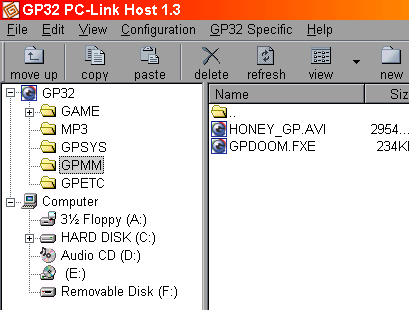 PC-Link - to transfer and install files to SMC!
PC-Link - to transfer and install files to SMC!
 Free Launcher - to run emus and homebrew apps on GP32!
Free Launcher - to run emus and homebrew apps on GP32!
It's a relatively simple matter of using menus and drag/drops to send
everything to the SMC. You can also use a card reader/writer, which will
be much faster and possibly more reliable for some users, although some
files really need PC-Link. The most annoying aspect of PC-Link is the
8.3 file naming convention. Luckily there are hacked versions of the
software to get around this issue, so it's not so bad.
And that about wraps up part one of my GP32 FLU review. Overall, if
you're only interested in NEW commercial software from major developers
like Nintendo, Capcom, Square, Sega etc. then a GameBoy Advance SP is
the way to go. But if you're a true "Retrogamer," the GP32's emulation
capabilities might satisfy you even more, and there are some very nice
commercial titles albeit very few. And it serves as a solid MP3 and AVI
video player as well, something GBA can't claim without extra hardware.
It's a great piece of kit for
the money, ergonomically pleasing, and very versatile. I definitely
recommend spending the extra money for the FLU version, simply because
the internal lighting works very well, and is great to have despite some
minor drawbacks.
Here's Part Two: Software - one week late, and not
nearly as complete as I would've liked, but it's done. :) Phew!
Following are a series of pertinent GP32 links, including places to
buy
them. I hope my review was helpful and informative for some readers, and
hopefully we'll
all meet again in one week for part two: GP32 Software and Emulators.
English GP32 homepage
Stores:
Play-Asia - Great Hong Kong based
store, GP32 plus MUCH more!
GBAX - CraigX's superb store,
ESPECIALLY for European buyers!
Lik-Sang - Well known videogame
import store!
JoyGP - To buy & download GP32 software!
GP32 News & Downloads:
GP32Emu - GREAT GP32 site!
GP32 Xtreme - Superb news & message
boards!
GP32 News - Another solid news
site!
PDROMS GP32 -
tons of homebrew goodies!
GP32 Development & Tools (just a few...):
GP32 Dev'rs
CHN's GP32 page
DarkFader's GP32 page
top of
page |

